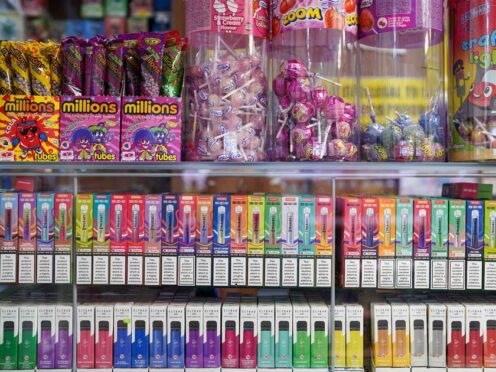
Disposable vapes are driving up the use of highly-addictive nicotine in England, reversing a historic trend, according to a new study.
Experts from University College London (UCL) found increasing nicotine use is being “driven primarily by sharp increases in vaping among young people”.
The study, funded by Cancer Research UK, looked at data on vaping and smoking for 132,252 people in England from July 2016 to May 2023.
Researchers wanted to examine changes in vaping and smoking before and after disposables became popular in June 2021.
The study found that, in England up to June 2021, smoking and vaping had been stable or declining across all age groups.
“However, since disposable vaping started to become popular, vaping has been increasing across all age groups – especially younger adults (18 to 24-year-olds),” it said.
The proportion of 18 to 24-year-olds who said they vaped tripled over the period, rising from 9% in May 2021 to 29% in May 2023.
Smoking in this age group declined from 25% to 21%, but overall nicotine use increased from 28% to 35%.
In older age groups, vaping prevalence increased from 5% to 6% among those aged over 45, while smoking also increased from 12% to 14%.

The rise in vaping was greatest in people who had never smoked, rising from 2% to 9% in 18 to 24-year-olds.
Overall, the researchers said that, after disposables became popular in 2021, the odds of people saying they vaped increased by 99% per year among 18 to 24-year-olds, compared with 39% in 25 to 44-year-olds and 23% in those aged 45 or older.
The team concluded: “Since disposable vapes started becoming popular in England, historic declines in nicotine use have reversed.
“Now, nicotine use appears to be rising, driven primarily by sharp increases in vaping among young people.
“Smoking declines have been most pronounced in age groups with the largest increases in vaping.
“Urgent action is needed to curb the rise in disposable vaping among people who would otherwise avoid nicotine entirely.
“This could include an excise tax, packaging restriction, and putting vapes behind shop counters.”
Lead author Dr Harry Tattan-Birch, from UCL, said: “The rapid rise in vaping would be less concerning if smoking rates had come down more rapidly.
“The overall increase in the use of nicotine shows this has not happened.
“Instead, driven by the arrival of highly popular disposable e-cigarettes, vaping has become much more common among young people, some of whom would likely otherwise have avoided nicotine entirely.
“Given these findings, the UK Government’s current Tobacco and Vapes Bill to reduce youth vaping is welcome.”
The Tobacco and Vapes Bill would make it illegal to sell tobacco products to anyone born on or after January 1, 2009.
It also aims to cut youth vaping through tighter controls.
However, on Thursday it looked like the Bill may get shelved after Prime Minister Rishi Sunak called a surprise General Election in July.
Senior author of the new study, Dr Sarah Jackson, from UCL, said: “While action is needed to counter the rise in vaping among young people who otherwise would not use nicotine, policies should avoid signalling that e-cigarettes are a worse alternative to smoking tobacco. Vaping may not be risk-free, but smoking is uniquely lethal.
“It is also critical that policies designed to make e-cigarettes less attractive to young people do not inadvertently make these products less effective for helping people to stop smoking.
“Measures that target vaping products’ appearance, packaging, and marketing rather than their flavours and nicotine content may be most effective in striking this balance.”
Dr Ian Walker, Cancer Research UK’s executive director of policy, said: “This study shows a concerning increase in the number of young adults using vapes since disposables came on the market in the UK.
“Evidence to date shows that vapes are far less harmful than cigarettes, but they can’t be considered risk-free and certainly shouldn’t fall into the hands of children or those who have never smoked.
“A continued decline in smoking rates is encouraging to see, but we can’t become complacent – smoking is still the biggest cause of cancer in the UK and it’s vital that we protect the next generation from a lifetime of addiction.”
The study was published in the journal Lancet Regional Health – Europe.
It comes as the World Health Organisation (Who) published a report saying vapes and other new tobacco and nicotine products “present a grave threat to youth and tobacco control”.
Dr Tedros Adhanom Ghebreyesus, Who director general, said: “History is repeating, as the tobacco industry tries to sell the same nicotine to our children in different packaging.
“These industries are actively targeting schools, children and young people with new products that are essentially a candy-flavoured trap.
“How can they talk about harm reduction when they are marketing these dangerous, highly addictive products to children?”
Dr Ruediger Krech, Who director of health promotion, said: “The use of child-friendly flavours like cotton candy and bubblegum, combined with sleek and colourful designs that resemble toys, is a blatant attempt to addict young people to these harmful products.”

Enjoy the convenience of having The Sunday Post delivered as a digital ePaper straight to your smartphone, tablet or computer.
Subscribe for only £5.49 a month and enjoy all the benefits of the printed paper as a digital replica.
Subscribe